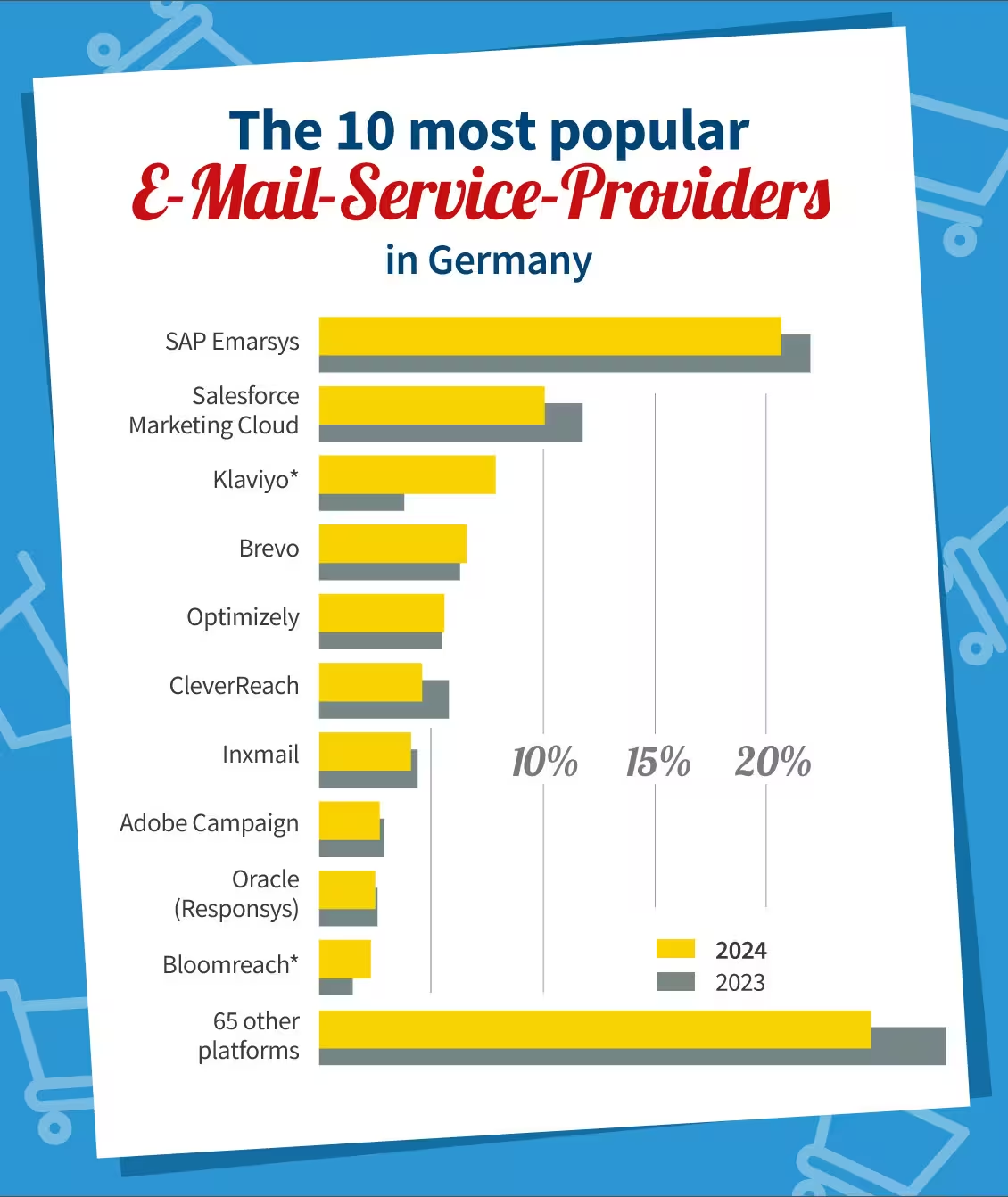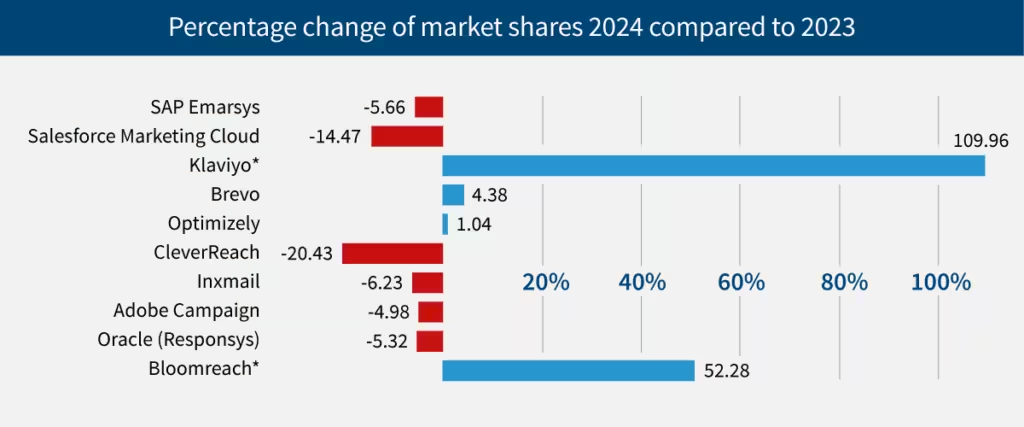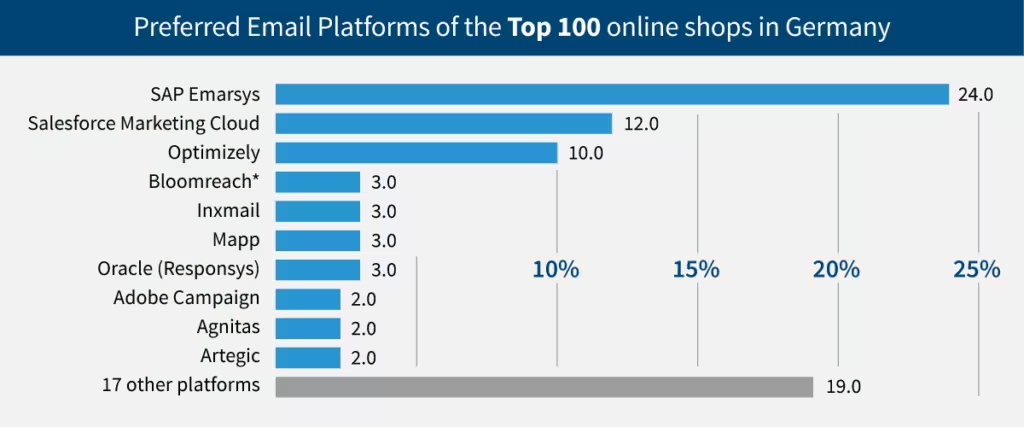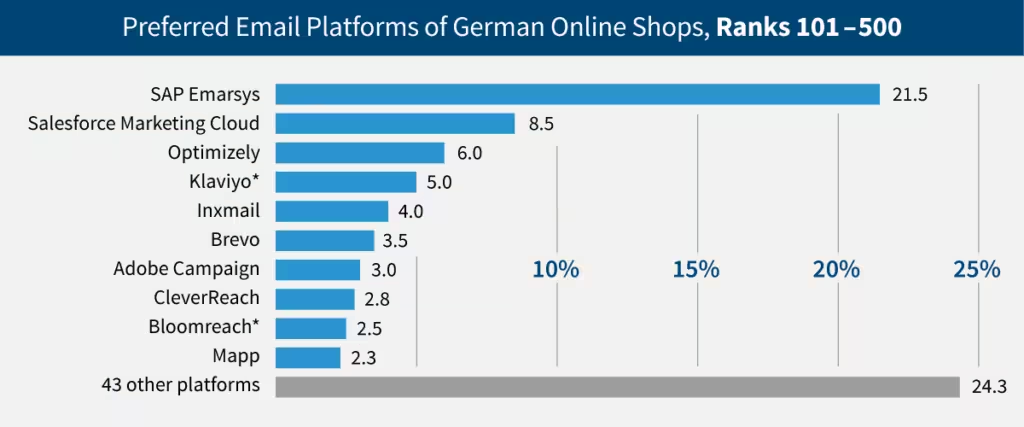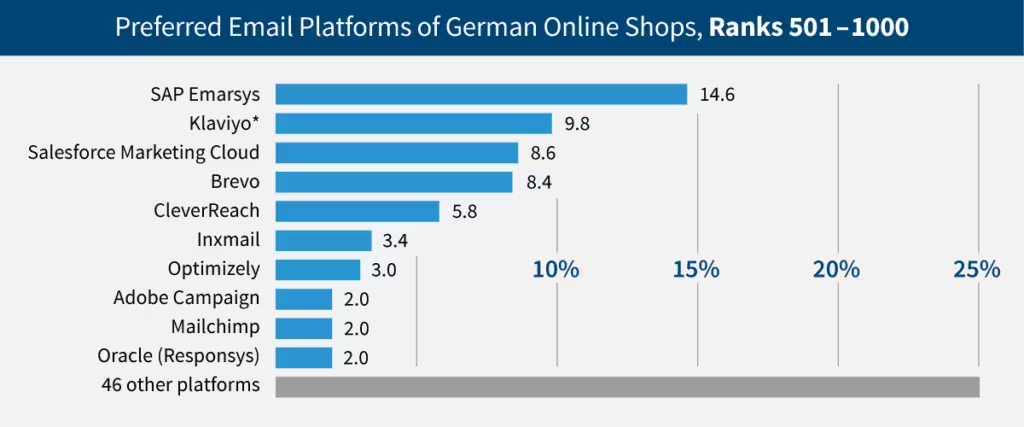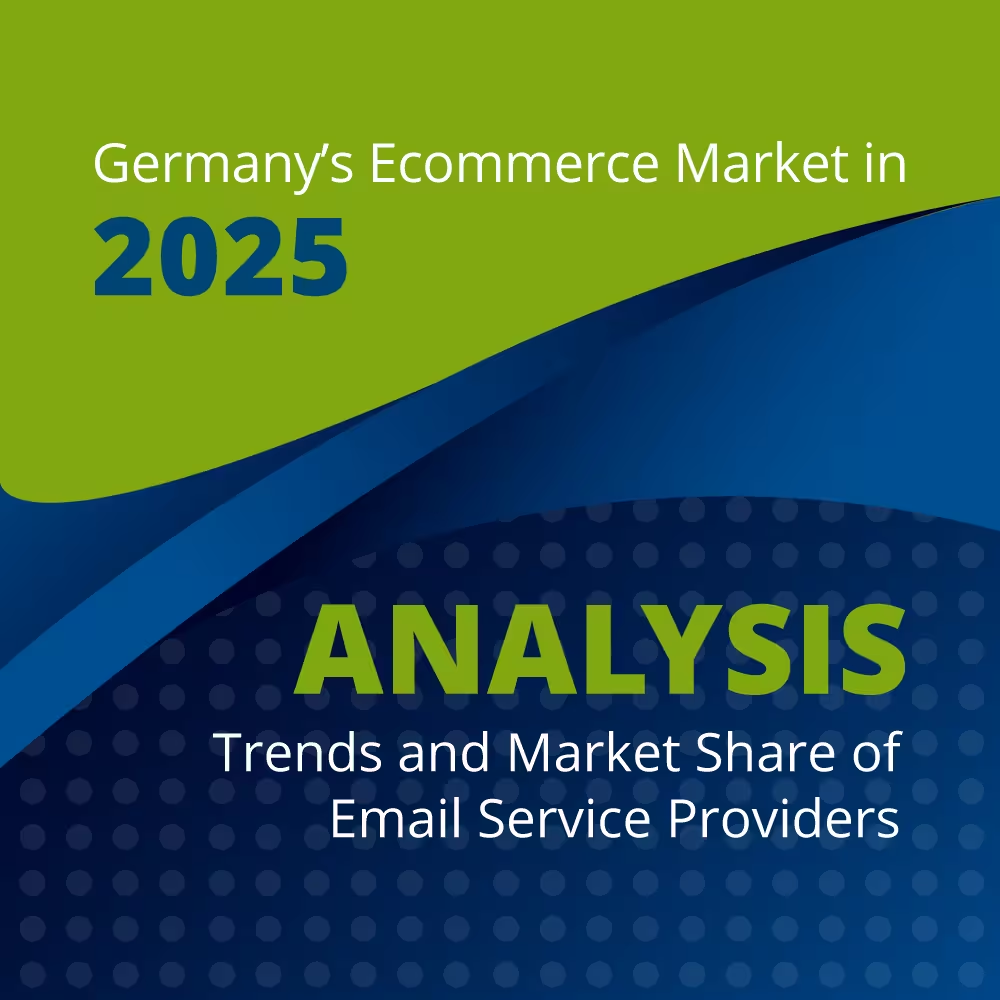Email marketing of the 1,000 top-selling German online shops 2024
The 1,000 top-selling online shops in Germany rely on continuity in email marketing — and at the same time on change. This is the only seemingly contradictory result of the annual survey of the most-used email service providers, which we carried out for the seventh time in a row on behalf of the EHI Retail Institute and eCommerceDB (”Study: German e-commerce market 2024“).
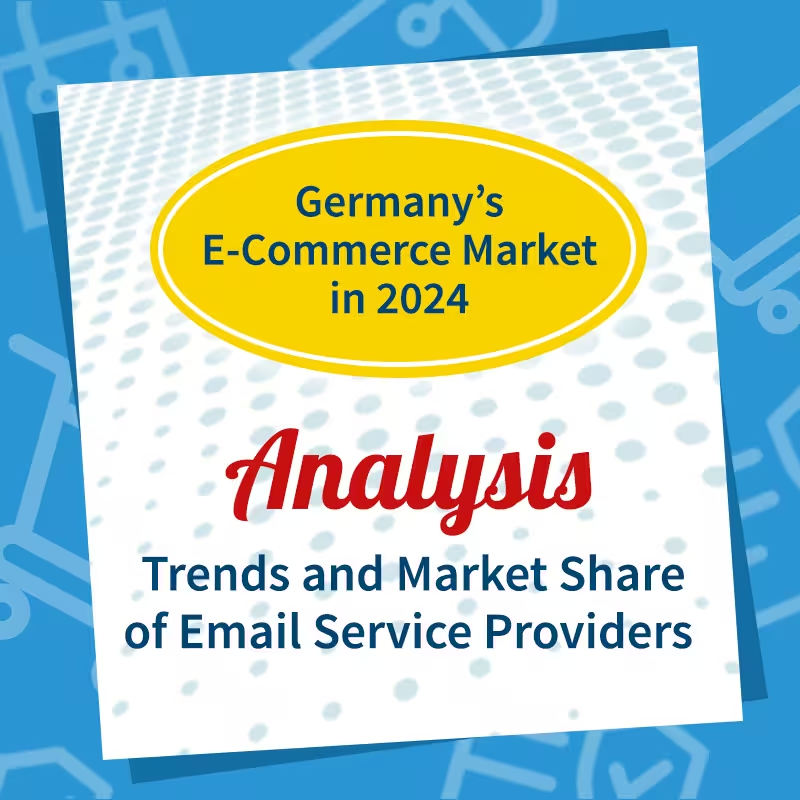
Here you can find the latest analysis results for Email marketing of the top 1000 e-commerce companies in Germany 2025
Market shares of email service providers
As in previous years, the most-used email systems are at the forefront SAP Emarsys and Salesforce Marketing Cloud. Both continue to cover around a third of the surveyed market, but with a slight downward trend (30.8% compared to 33.8% in 2023). Klaviyo continues its global advance in the German market as well and was able to more than double its market share to 7.9% within one year (2023:3.4%). The now publicly traded Americans are thus overtaking the “self-service” platforms established in this country CleverReach and Brevo (formerly Sendinblue & Newsletter2Go). New to the top 10 most-used platforms is BloomReach.
Gains and losses
Looking at gains and losses, it is clear that BloomReach and Klaviyo can record the largest percentage gains while CleverReach has to accept the biggest loss of market share in the top 10. The formerly widespread Mailchimp is only used by 2.2% of high-turnover e-commerce companies and is no longer in the top 10.
Market segmentation: Different preferences based on company size
As expected, SAP Emarsys and Salesforce Marketing Cloud dominate the 100 largest shops in Germany. Optimizely (formerly Optivo Broadmail/Episerver) is in 3rd place and BloomReach is just as frequently used in this group as Inxmail, Mapp and Oracle. The self-service platforms Klaviyo, Brevo or CleverReach are not among the top 100 platforms with the highest turnover.
A different picture emerges when looking at shops in the middle segment (EHI E-Commerce rank 101 — 500) with e-commerce net goods turnover of 19 million to 116 million euros per year). In this segment, SAP Emarsys is 2.5 times as often as Salesforce Marketing Cloud (“only” twice as often in the top 100); Klaviyo, Brevo and CleverReach make the leap into the top 10 in this segment.
SAP Emarsys also tops the list in the bottom half of the top 1,000 list — but only 15 percent of shops here afford this omnichannel marketing platform. Klaviyo is in second place, well ahead of Salesforce Marketing Cloud. This revenue segment has the largest variety of email marketing platforms used and, at 15%, also the majority of online shops that have not sent us a single marketing email in the last 12 months. In this analysis, it is easy to see that the market segments considered have different solution preferences: The sales at sales rank 501 to 1000 allow (or: require?) Investing in a multichannel marketing automation platform is less common, the focus is on cheaper pricing.
What our analysis also shows: Despite growing digital channels, email remains an integral part of the e-commerce marketing mix: 88.2% of all shops examined send marketing emails, only 4.4% do not offer newsletter registration. Almost all shops use an email service provider for their email marketing, namely 91.8% of the 882 shops that sent us at least one marketing email in the 12-month investigation period.
Waiting for consolidation in the email marketing market
At this point last year, we asked: “Where is the innovation?” However, the hoped-for consolidation is still a long way off and the email and multichannel platform market remains highly fragmented. In addition to the 10 most popular platforms, the top-selling online shops use a further 65 platforms with a combined market share of 24.7%. The two long-standing market share winners SAP Emarsys and Salesforce Marketing Cloud maintain their top positions. Whether the shrinking of their shares indicates that these platforms have reached their zenith after almost a quarter of a century on the market will only be revealed in the coming years.
Younger competitors are now gaining in importance: Klaviyo with a strong e-commerce focus and BloomReach with an integrated Customer Data Platform (CDP) now play a significantly larger role among the top 1000 e-commerce companies than they did one to two years ago. The development on the German market has some parallels with developments on the American market. Read here what email marketing platform trends look like in America.
Platform change challenges: Never Change a Running System
Changing the marketing platform involves significant costs and risks. Our long-standing analyses show that digital marketing managers are remarkably loyal to their email platforms:
- 44% of the shops that have been among the top 1000 online shops in Germany since the start of our studies have not changed their platform in the last seven years.
- 40% of shops only changed their email platform once during this period.
- Only 15% of shops changed their marketing platform every two to three years.
Individual paths to success: email marketing in diversified e-commerce
In the e-commerce market, two main groups of email marketing are emerging: benefit maximizers who want to exploit the full potential of their customer base with powerful tools, and cost minimizers who want to achieve email-generated sales with minimal effort. Although this division correlates with the size of the company, it does not allow a clear allocation. The largest e-retailers tend to have fewer cost minimizers, yet all platform solution classes are represented in all market segments, albeit in different distributions.
The choice of the optimal email marketing technology is not determined solely by company size, range of functions or industry focus. Instead, strategic orientation and available marketing resources play a decisive role. Each online shop develops its own strategies to successfully survive intensive digital competition.
The market shares of most popular email service providers among the EHI top 1,000 e-commerce companies in Germany
Here you can see which email marketing delivery solutions are used and how often by the e-commerce companies examined:
Email delivery system types used by online shops
About the methodology
Basis: Evaluation of the 1,000 best-selling B2C online shops and the top 10 B2C marketplaces in 2024, determined by EHI Retail Institute and eCommerceDB: “Study: E-Commerce Market Germany 2024", sorted by e-commerce sales in fiscal year 2023.
Online shops that sent promotional emails via a shipping solution identified as an ESP, sending service or web shop email module during the investigation period of 12 months. The percentage market share is calculated from the number of companies for which the respective sender was identifiable. n = 882
* Identified front-end tool — using a shipping service on the back-end.
** Market share in percent minus the percentage of e-commerce companies for which we were able to identify a front-end marketing automation platform that ships via a shipping service. When we were able to identify the front-end solution, the market share was attributed to that solution.
Mailjet


